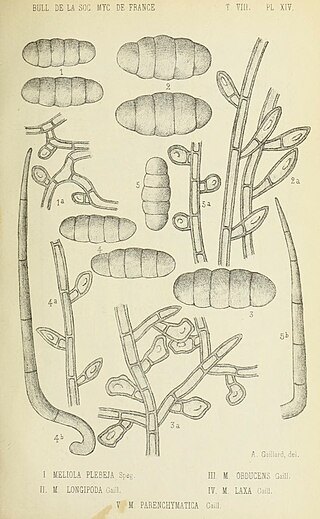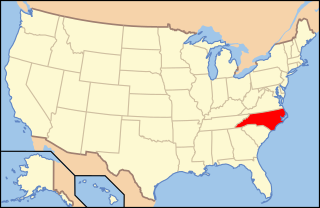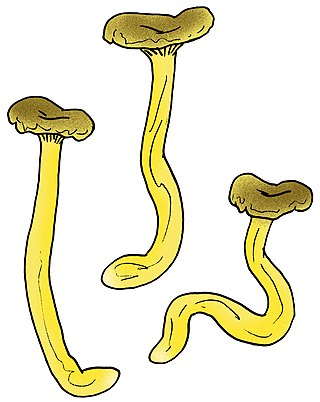
A hypha is a long, branching, filamentous structure of a fungus, oomycete, or actinobacterium. In most fungi, hyphae are the main mode of vegetative growth, and are collectively called a mycelium.

Meliola is a large genus of fungi in the family Meliolaceae. It was circumscribed by Swedish mycologist Elias Magnus Fries in 1825.

The Meliolaceae are a family of fungi in the order Meliolales. Mostly tropical in distribution, species in this family are biotrophic on the leaves and stems of plants. Despite this, most species do not cause extensive damage to the host plant, and are not generally considered to be of economic significance.
Bruceomyces is a fungal genus in the family Bruceomycetaceae, containing the single species Bruceomyces castoris.

Cortinarius cinnamomeus, also known as the cinnamon webcap, is a basidiomycete mushroom of the genus Cortinarius. The fungus produces brown fruit bodies with caps up to 6 cm (2.4 in) wide and stems up to 12 cm (4.7 in) long. The closely crowded gills underside the cap are initially yellow before turning brown. Cortinarius cinnamomeus is common in damp places in coniferous forests. It is distributed throughout the temperate zone of the Northern Hemisphere.

Paraphaeosphaeria pilleata is a species of fungus in the Lophiostomataceae family. The species fruits exclusively in the lower parts of the culms of the black needlerush. It is found on the Atlantic Coast of North Carolina.
Morchella meiliensis is a species of fungus in the family Morchellaceae native to China.

Engleromyces sinensis is a species of fungus in the family Xylariaceae. It was described as new to science in 2010, based on specimens collected in 1958 and incorrectly identified as Engleromyces goetzii. The fungus is known only from China, where it grows on bamboo culms. It forms fruit bodies in the shape of two roughly circular buff-colored lobes measuring up to 50 cm (20 in) in diameter that envelop the bamboo. E. sinensis has been used as a folk remedy against cancer and infection in Tibet, Yunnan, and Sichuan Provinces. Several bioactive metabolites have been isolated and identified from the fungus.

Tuber polyspermum is a species of truffle in the family Tuberaceae. Found in China, it was described as new to science in 2011. Fruit bodies of the truffle are small and brown, measuring up to 1.5 cm (0.6 in) in diameter.

Coccomyces dentatus is a species of fungus in the family Rhytismataceae. A widespread species, particularly in temperate areas, it colonizes the dead fallen leaves of vascular plants, particularly oak and chestnut. The fungus apothecia, which form in the epidermal layer of the leaf host, resemble dark hexagonal spots scattered on a multi-colored mosaic pattern bounded by thin black lines. When mature, the apothecia open by triangular flaps to release spores. The anamorph form of C. dentatus is Tricladiopsis flagelliformis. Lookalike species can be distinguished by the shape of the apothecia, or by microscopic characteristics.

Cantharellus zangii is a species of fungus in the family Cantharellaceae. Described as new to science in 2012, it is found only in a small area in northwestern Yunnan, China. The fungus produces small, ochre to ochre-yellow fruit bodies (mushrooms) with thin flesh and a long tapering stipe. Microscopically, the mushroom features thin-walled hyphae with clamp connections, and large ellipsoid-shaped spores.
Tylopilus punctatofumosus is a bolete fungus in the family Boletaceae found in China. It was described as new to science in 1948 by Wei-Fan Chiu as a species of Boletus; F.L. Tai transferred it to the genus Tylopilus in 1979. The fruit body has a hemispherical to cushion-shaped, white cap measuring 2–3.5 cm (0.8–1.4 in) in diameter. The pores on the cap underside measure less than 1 mm wide. The flesh in the stipe is whitish to yellowish at the base, and does not change color with injury. It has ellipsoid spores measuring 9–11 by 5–6 µm. The type collection was made in Chichushan, in September 1938 growing under the conifer species Chinese white pine. Related Asian Tylopilus species include T. javanicus and T. roseolus.
Strobilomyces glabriceps is a species of bolete fungus in the family Suillaceae found in China. It was described as new to science in 1948 by Wei-Fan Chiu. The type collection was made in Kunming in June, 1938.

Mu Zang was a Chinese mycologist. He was known for his research on the Boletales of China, and the ecology and biogeography of fungi in southwestern China. He described more than 140 new species and circumscribed three genera, published more than 150 research papers, was chief editor or co-editor for twelve books, and wrote two monographs on the Boletaceae of China. His final book, "Dictionary of the Families and Genera of Chinese Cryptogamic (Spore) Plants" was co-authored with his wife, Professor Xinjiang Li.
Pachyphloeus depressus is a species of ascomycete fungus that forms truffle-like fruitbodies. It is found in southwestern China, where it has been reported from Qiaojia County, Yunnan Province, and Huili County, Sichuan Province. These counties are both near the Jinsha River. Fruitbodies of the fungus are smooth and greenish-brown—distinctive features in the genus Pachyphloeus. They measure 0.9–2.1 cm (0.4–0.8 in) in diameter, and have a rubbery texture. When ripe, the odor of the flesh is similar to burned potatoes. Spores are spherical, measuring 15.7–20 µm with coarse rod-like spines up to 2.5 µm on the surface. The fungus has been called the "green female truffle" because of its superficial resemblance to the locally common species Tuber pseudohimalayense.
Meliola wainioi is a fungus species described as new to science in 1890 by French mycologist Narcisse Théophile Patouillard. It is named in honour of Finnish lichenologist Edvard August Vainio, who found the type specimen growing on "tough leaves". The type locality is Minas Gerais, Brazil. The fungus grows as a dense, thick woolly black spot on the leaf surface. It produces relatively large ascospores measuring 65–70 by 22–25 μm, typically divided by 3 septa; the terminal two spore segments are smaller than the middle segments.
Pseudopyrenula serusiauxii is a species of lichen-forming fungus in the family Trypetheliaceae. It is found in Papua New Guinea. The lichen appears as a greenish discolouration on the trunks of Macaranga trees.
Sclerococcum fissurinae is a species of lichenicolous fungus in the family Dactylosporaceae. Found in Alaska, it was formally described as a new species in 2020 by Sergio Pérez-Ortega. The type specimen was collected in the Hoonah-Angoon Census Area, just outside of Glacier Bay National Park. Here it was found growing on the script lichen species Fissurina insidiosa, which itself was growing on the bark of an alder tree. The specific epithet refers to its host.
Meliola brevispora is a species of fungus in the family Meliolaceae. It was first described in 1987 by Marie Farr, from a specimen found on the leaves of a plant in the family, Guttiferae, in Brazil.
Fuscopannaria dispersa is a species of corticolous (bark-dwelling), squamulose lichen in the family Pannariaceae. It is found in China, where it grows on the bark of several tree species at an elevation range from 3,650 to 4,300 m, close to the forest limit. It was formally described as a new species in 2000 by Norwegian lichenologist Per Magnus Jørgensen. The type specimen was collected by Joseph Rock from the eastern slopes of Likang Snow Range in 1922, and has since been documented in a few locations in eastern China. The lichen has a brown thallus made of small squamules spread out over a distinct black prothallus. Its ascospores are ellipsoid, colourless, lack septa, and measure 15–17 by 9–10 μm. Fuscopannaria dispersa is similar to the more widespread F. leucosticta, but can be distinguished from that species by the squamulose form of its thallus and by its smaller, rounder ascospores.









